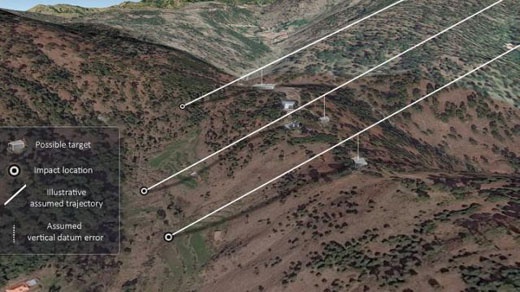Balakot Strikes Missed, Targeting Error Possible Cause: Aus Report
Mangalore Today News Network
Islamabad, Mar 27, 2019 : Amid India’s claims and Pakistan’s counter-claims on the efficacy and potency of the air strikes conducted by the Indian Air Force in PoK’s Balakot, a new report based on high-resolution satellite imagery claims that the intended targets – JeM terror camps – were not ‘visibly damaged’, Yahoonews reported.

The report, by Australian Strategic Policy Institute (ASPI), claims that publicly available satellite imagery acquired by European Space Imaging the day after the strike suggests that buildings at the camp were not “visibly damaged or destroyed”.
The imagery (of a higher resolution than previously available) shows conspicuously undamaged roofs, says the report, which runs counter to Indian claims of “successfully destroying the intended targets”.
The report also claims that the damage (or lack thereof) is not “consistent with either a SPICE 2000 strike or a strike with other munitions”.
“We believe that even a weapon with reduced explosive fill would cause damage to buildings that would be identifiable in the satellite imagery,” the authors of the report claim.
A mapping of the Balakot air strikes, as per the report.
The Balakot air strikes have been at the centre of a political storm in India, with several leaders of the ruling dispensation claiming that the air strikes had inflicted ‘serious damage’ on the JeM campsites, leading to anywhere from 200 to 400 casualties.
The IAF, meanwhile, has refused to disclose a head count but confirmed that “all intended targets had been hit”.
Targets Missed by ‘Similar Distances’
Another striking claim made by the report was that, as per the high-resolution images, all three weapon strikes missed their intended targets by similar distances. They all also missed in the same direction.
This, the authors’ claim, suggests that the misses were “caused by a systematic targeting error”.
This error was likely caused in a scenario in which the Indian Air Force opted to rely solely on the weapon’s ‘set and forget’ GPS capabilities, they said.
“One explanation for the miss is that the SPICE 2000 bombs were incorrectly programmed to fly precisely into GPS points that were, say, 33 metres above their intended targets (the buildings on top of the ridge line). They performed as programmed and then continued on their trajectories until they struck the valley beneath,” the report said.
A mapping of the Balakot air strikes, as per the report.
“The buildings that were the likely targets and a discrepancy between ellipsoidal and orthometric height which we have assumed to equate to 33 metres above the target buildings. Presented in 3D, this correlation results in consistent, parallel trajectories indicating a consistent targeting error,” it added.
Another possible explanation for the weapons ‘missing’ their targets was the inter-operational frailties of using French jets, Israeli weapons, US GPS and a targeting system that potentially used maps based on an older local Indian datum, the report said.
- Mangaluru: People savour jackfruit manchurian, momos at ‘Halasina Mela’
- Gold ornaments worth Rs. 2.16 lakh stolen
- Udupi: Students accused of obstructing police’s work
- 9 arrested for gambling near railway track at Baikampady
- Orange alert declared for Dakshina Kannada on May 19, 20
- Natural Ice Cream Founder Raghunandan Srinivas Kamath passes away
- Unity Academy of Education holds Graduation and Diploma Awarding ceremony-2024
- INTACH and Art Kanara Trust to present exhibition of Mangaluru heritage drawings and sketches
- Kasaragod: SIT formed to nab accused in child abduction case
- Udupi farmer makes Rs 3 lakh per kilogram of mangoes from his terrace garden
- Youth turns Good Samaritan; rescues child from well
- Nitte Institute of Hospitality Services exploring the World of Bartending as a career choice
- Puttur: Man dies after surgery in hospital; family alleges medical negligence
- Karnataka sex video scandal: Court issues arrest warrant against Prajwal Revanna
- Telugu actor Chandrakanth dies by suicide days after death of co-star Pavithra Jayaram
- Indian students in Kyrgyzstan asked to stay Indoors amid mob attacks
- Kerala to receive heavy rains; IMD issues red alert in some districts for May 19, 20
- Swati Maliwal assault case: Kejriwal’s aide Bibhav Kumar arrested by Delhi Police
- Air India Express passenger detained for false bomb threat at Bengaluru airport
- Deve Gowda breaks silence on sex tapes case involving his grandson
- Bullied and shunned at school, Himachal trans woman is now an ’Election Icon’
- Bihar man, minor wife die in custody, angry mob sets police station on fire
- In 10 years, India adds 31,000-km rail network - equal to all of Germany
- Rohit Sharma gets standing ovation from Wankhede crowd after possible farewell knock
- No Government can change constitution: Nitin Gadkari
- New residential complex for the judges inaugurated in Mangaluru
- Absconding accused nabbed after 8 years
- Truck with cylinders turns turtle in Beltangady
- Bhoota Kola artist dies of cardiac arrest
- Development of the country should be our goal: Ganesh Karnik
- Container truck gets stuck under Modankap railway bridge
- Truck crushes bike’s pillion rider near BC Road
- Head constable dies of heart attack
- Udupi: PDO dismissed over financial irregularities
- CREDAI to resume Skill Development Program for Construction Workers in Mangaluru
- John B Monteiro elected president of Rachana Catholic Chamber of Commerce & Industry
- Sudhanshu Rai elected district president of All College Student Association
- Chief Minister to visit Mangaluru, Udupi on August 1
- Nitte University awards PhD degree to Tina Sheetal D’Souza
- Sachitha Nandagopal honoured by CMTAI for Community Service
- CITY INFORMATION
- TRAVEL
- TOURIST INFORMATION
- HEALTH CARE
- MISCELLANEOUS




 Write Comment
Write Comment E-Mail To a Friend
E-Mail To a Friend Facebook
Facebook Twitter
Twitter  Print
Print 

